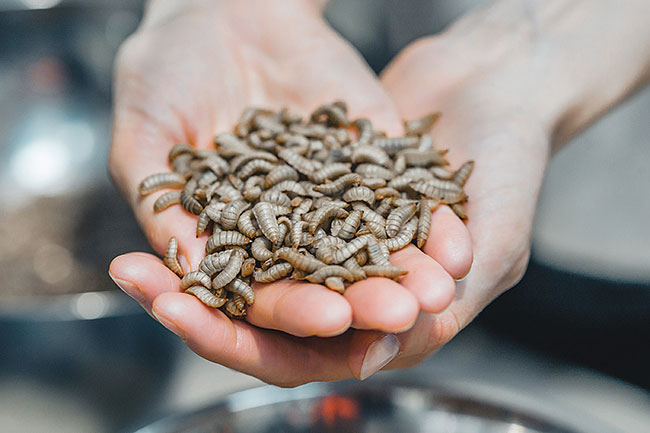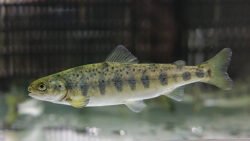
New fraction from insect meal tested in feed: Nofima study
December 19, 2023
By Norwegian Institute of Food, Fisheries and Aquaculture Research
 Black soldier fly larvae are processed into the three fractions for feed: oil, meal and stickwater. Photo: Innovafeed
Black soldier fly larvae are processed into the three fractions for feed: oil, meal and stickwater. Photo: Innovafeed Insects are a natural part of the diets of wild salmon when they are in rivers. Insects are also making their way into the diets of farmed salmon.
When Norwegian scientists at the Norwegian Institute of Food, Fisheries and Aquaculture Research (Nofima) wanted to test the species of insect called black soldier fly in salmon feed, it was, therefore, natural to measure the effects on salmon parr, which are young, freshwater salmon.
Insects are towards the bottom of the food chain and require little area to thrive and are therefore an attractive type of feed ingredient to investigate in the search for more sustainable fish feed. The species of insect investigated in this trial was the black soldier fly. It is produced at the factory of insect producer, Innovafeed, in France and processed for use in feed during its larval stage.
Using the whole insect in feed

Nofima’s trials show that salmon parr like feed that contains insect meal, and grow just as well with stickwater in the feed as without. Parr is the stage between fry and smolt. Photo: Terje Aamodt, Nofima
Currently, not all of the insect is used in feed. The larvae are processed into the three fractions of oil, meal and stickwater. It is the latter two fractions that were tested in feed for juvenile fish. The meal is rich in protein, and stickwater is thought to be rich in bioactive components. The properties these fractions have in fish meal are already well known. From a bioeconomic perspective, it is therefore desirable to test and utilize this resource from insects in salmon feed.
Nofima scientists and a master’s student at Norwegian University of Life Sciences (NMBU) measured the effect on digestion and growth in juvenile fish during the growth phase from approximately 20-85 grams.
At Nofima in Bergen, Norway, feed technologists produced trial feed in which they added 10 percent insect meal and different levels of stickwater from insects. The insect ingredient was compared in feed with similar protein content and replaced half of the fish meal in a control diet. The feeds were given to salmon parr held in trial tanks at Nofima’s Sunndalsøra research station.
The goal was to find any differences in digestion and growth in fish that were fed feed based on insects with an increasing content of stickwater.
Grew just as well

Senior Scientist André Sture Bogevik at Nofima
Photo: Helge Skodvin, Nofima
The trials showed that salmon grew just as well and had just as good digestion when their diet contained stickwater from insects. With 10 percent insect meal in the feed, the fish also grew just as well as fish that received the control feed.
“The trial shows that there is no problem in salmon having at least 10 percent insect meal in their feed. Based on the positive effects of the stickwater fraction from fish meal, we cannot rule out that this fraction from insects would have had a positive effect under other conditions. In any case, it is an important side stream to safeguard for the optimal utilisation of insects as feed for fish”, says Nofima’s Andre Sture Bogevik.
In the project, the level of the mineral manganese was also investigated. The EU has threshold values for the content of manganese in the finished feed for farmed fish, and insects contain naturally high levels of this. The trial showed that the fish excrete the mineral and do not absorb more in the body than if the meal did not contain high levels of manganese. Nor did the mineral lead to any deformities or have a negative impact on growth.
“We are delighted to observe results aligned with the internal research we have carried for the past years at Innovafeed,” said Innovafeed director, Elin Kvamme. “The growth results pave the way for the widespread use of insect protein in the salmon industry, as a sustainable, traceable, and performing ingredient.”
Research on low-trophic raw materials
The research was conducted in the Millennial Salmon project, which is funded by the Research Council of Norway. The research is published in the Master’s thesis of Erika Marie Hanson at NMBU in 2022 entitled, “Effects on growth and welfare of Atlantic salmon parr, feed diets with 10 percent BSFL meal, with different inclusions of BSFL stickwater.”
Nofima senior scientist, Katerina Kousoulaki, is the project manager for the Millennial Salmon project, which focuses on optimizing and using heterotrophic microalgae and insect meal as replacements for large parts of fish oil and soy in salmon feed.
Advertisement
- PEI’s Atlantic Aqua Farms receives $3.4M for triploid mussels breeding program
- ScaleAQ urges farmers to check mooring system for safety





